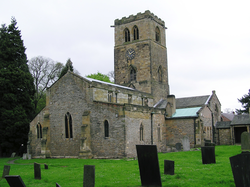
The Corpus of ROMANESQUE SCULPTURE in Britain & Ireland

Nottingham (now)
Parish church
Since 1877 Lenton has been a part of the City of Nottingham, but in the 11thc it was a village to the W, between Nottingham and Wollaton. New Lenton was built on farmland to the W of Lenton to accommodate the expansion of both the village and the city, especially of the lacemaking industry. The church of the Holy Trinity was built in 1842 by Henry Isaac Stevens, and consists of a nave with aisles, chancel and W tower. It houses the font from Lenton Priory; one of the finest pieces of Romanesque sculpture in the county.
Parish church
Clifton is a large suburban village in the Cirty of Nottingham, 3 miles S of the city centre. The church is in the part of Clifton called Clifton village, which also includes Clifton Hall, on the site of the medieval manor, home of the Clifton family since the 13thc. St Mary's is a cruciform building consisting of a chancel, N and S transepts, central tower, clerestoried nave with aisles, a N porch and a modern extension beyond the S transept. The N arcade is the oldest part of the present church and the two most easterly bays would appear to date from around 1200. At a later date the church was extended westwards by one bay and the W respond of the arcade moved and an additional pier with a plain capital inserted. The S arcade, also of three bays, dates from the 14thc. The two lower stages of the crossing tower are also 14thc. while the upper stage is 15thc., as is the chancel.
The S transept contains a considerable number of tombs of the Clifton family who were Patrons of the church. Under a licence dated 24 October 1476 Sir Robert Clifton established a chantry. This was confirmed in the reign of Edward IV and consisted of a warden and two chaplains.
The church was restored in 1893-94 and again in the 1960-70s, this time with George Pace as architect. The only Romanesque feature, and that a late one, is the arcade between the nave and N aisle.

